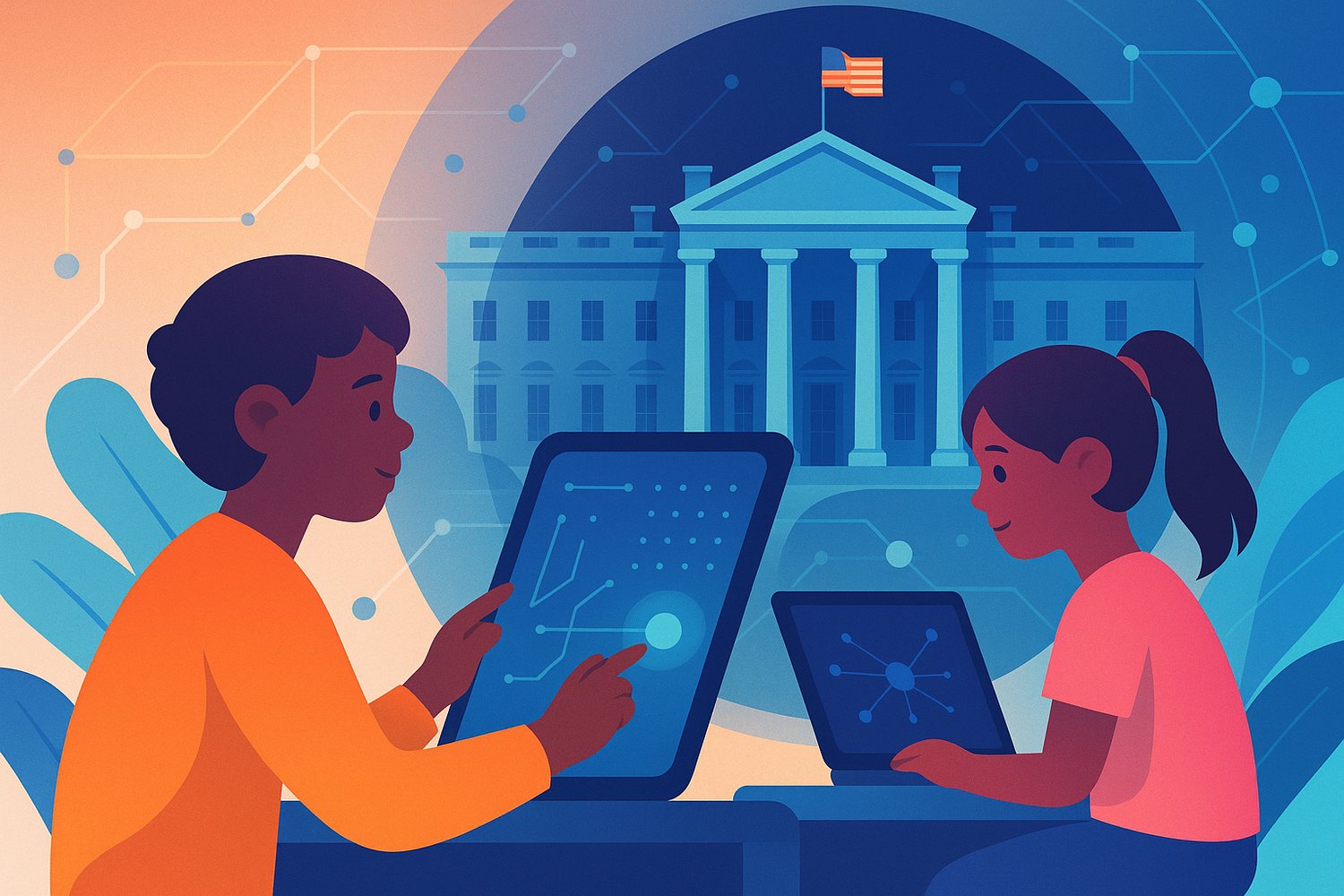Education
LittleLit latest to join White House AI Education Taskforce

Dipti Bhide, CEO of LittleLit, announced in a LinkedIn post that the company will participate in the White House AI Education Taskforce.
The initiative follows the April 2025 executive order on advancing AI education for American youth, which set out a plan for every K-12 student in the United States to receive meaningful AI skills training.
LittleLit develops a project-based, interactive AI curriculum designed specifically for K-12 learners. Its platform is grade-leveled, embeds ethics and safety, and includes over 1,000 AI “missions” to help students apply job-related skills across a range of professions. According to the company, more than 15,000 students, families, and educators across North America already use the program.
LittleLit’s move to join the White House AI Education Taskforce comes alongside broader national efforts to expand AI literacy in schools. Last week, the White House convened major technology companies including Amazon, Google, Anthropic, and Brainly, securing funding, training, and tools to support K-12 classroom. First Lady Melania Trump highlighted the importance of early adoption, stating: “Teaching students AI literacy from an early age is key to American success. The robots are here. Our future is no longer science fiction.”
Bhide says in her LinkedIn post: “Excited to share – LittleLit Joins White House AI Education Taskforce, Pledges to Equip K-12 Schools With AI Skills for the Future Workforce. Our mission has always been simple: AI Skills for every child to prepare for the future workforce. Now, as part of the White House AI Education Taskforce, we’re ensuring every K-12 school has the tools to teach AI — safely, meaningfully, and for all students.”
The ETIH Innovation Awards 2026
Education
Earl Richardson, who spotlighted HBCU funding disparities, dies : NPR

Earl Richardson was the president of Morgan State University between 1984 and 2010.
Morgan State University
hide caption
toggle caption
Morgan State University
Earl Richardson was a Black college president — “armed with history,” as a colleague described him — when he led a 15-year-long lawsuit that ended in a historic settlement for four Black schools in Maryland and put a spotlight on funding disparities for all of the nation’s historically Black colleges and universities (HBCUs).
Richardson’s death, at 81, was announced on Saturday by Morgan State University, located in Baltimore, where he served as president when he helped organize the lawsuit that began in 2006. It was settled in 2021 when the state of Maryland agreed to give $577 million in supplemental funding over 10 years to four HBCUs.
Richardson led Morgan State from 1984 to 2010 and he had long chafed at stretching the little funding he got from the state. In the lawsuit, plaintiffs argued that Maryland had historically underfunded its Black colleges and had put them at a disadvantage by starting and boosting similar programs at nearby majority-white schools.
David Burton, one of the plaintiffs, told NPR that the case was compared to Brown v. Board of Education, the landmark lawsuit that brought up similar issues of disparities in educational opportunities for Black students, but the Maryland case raised the issues for students in higher education.
In 1990, when Richardson was a new school president, students took over the administration building for six days to protest the school’s dilapidated classrooms and dorms, with roofs that leaked and science labs stocked with outdated equipment.
Edwin Johnson was one of those student protesters. “We originally were protesting against Morgan’s administration,” including Richardson, he said. “But then after we dig and do a little research, we find out it’s not our administration, but it’s the governor down in Annapolis that isn’t equipping the administration with what they need to appropriately run the school.”
The protest ended when the students marched 34 miles to Annapolis to demand a meeting with the governor.
Richardson, who spoke of taking part in civil rights demonstrations when he was in school, had subtly guided the students to the correct target, said Johnson, who is now the university’s historian and special assistant to the provost.
That protest helped pave the way to the future, historic lawsuit.
Because Richardson was the university’s president, and an employee of the state, he couldn’t sue the state. So, a coalition of students and former students was created, the Coalition for Equity and Excellence in Maryland Higher Education Inc., to serve as the plaintiff.
Still, Richardson was the visionary behind the lawsuit, said Burton, a Morgan State alumnus and now a strategic planner for businesses. “He was armed with history,” Burton said.
“Dr. Richardson knew where the skeletons were,” Burton added. He was “a force that the state could not reckon with because of his institutional knowledge.”
At one point, during the trial, state attorneys objected to Richardson’s presence in the courtroom and asked the judge to make him leave, even though he had a right to be there as an expert witness, said Jon Greenbaum, then the chief counsel of the Lawyer’s Committee for Civil Rights Under Law, who helped argue the lawsuit.
Richardson stayed in the courtroom and “because this was really a desegregation case,” said Greenbaum, he provided historical detail that became critical to the arguments made by the lawyers representing the plaintiffs.
The funding that resulted, and Richardson’s leadership, jump-started what is now called on campus “Morgan’s Renaissance.” Or sometimes, said Johnson: “Richardson’s Renaissance” — because during Richardson’s presidency, enrollment doubled, the campus expanded with new buildings and new schools were added, including a school of architecture and a school of social work.
Richardson’s work put a spotlight, too, on the funding disparities faced by HBCUs across the country. They are more likely than other schools to rely upon federal, state and local funding — money that has faced budget cuts in recent years. Compared to other universities and colleges, HBCUs get a higher percentage of their revenue from tuition and less from private gifts and grants, according to one study.
In testimony before the U.S. House of Representatives in 2008, Richardson emphasized the mission of HBCUs when he told lawmakers that Black schools like his educated the most talented Black students but also sought to attract students who didn’t consider, or thought they couldn’t afford, to go to college. “We can make them the scientists and the engineers and the teachers and the professors — all of those things,” he said. But only if “we can have our institutions develop to a level of comparability and parity so that we are as competitive as other institutions.”
Education
How millions of dollars in funding cuts will impact Hispanic Serving Institutions
Chancellor Sonya Christian of the California Community College system talks about the impact of funding cuts for students.
Education
Pvt schools bring in AI tools for better evaluation of students | Chennai News

Chennai: When Akansha (name changed) fumbled over a poorly worded maths question in her unit test, it wasn’t her teacher but an AI tool that came to her defence — flagging the flaw in the question and praising her for critical thinking instead of marking her wrong.“The software we are testing pointed out that though the student did not answer the question in a conventional sense, she possessed a critical-thinking ability that surpassed other students. It also pointed out that teachers should have framed the question better,” said Lakshmi Priya, principal, Prasan Vidya Mandir.Increasingly, private schools are purchasing tech and enterprise resource platforms to help teachers understand students’ mindsets better. Primarily set for elementary grades, up to Class V, these tools reduce the workload of teachers and help avoid bias creeping in during evaluation, Uma Kannan, owner, Sri Venkateshwara Institutions, said. “We experimented with a tool called AI Samrat in four of our schools. The improvements were very evident. Manually, it is difficult for teachers to understand where a student lacks if the class strength is high,” she added.Some schools started with a holistic progress card before transitioning into AI tools, which aligns with the vision outlined in the NEP. In this case, the answer sheets are manually corrected and uploaded onto the software. “The software then tells us ways to improve. Parents are also encouraged to provide their inputs for the holistic progress of a child,” said Radha Srikanth, principal, SV High, Arumbakkam.Chitra Ravi, founder of Chrysalis AI, a platform that provides such tools to schools, said there was a need for teachers to update themselves on the tech front to cater to students better. “AI constantly upgrades, and with time, we can even provide tech that can bring in a deeper assessment,” she added.Some schools, such as The Indian Public Schools, have also designed their own AI curriculum instead of purchasing software. Experts are appointed to train teachers in AI models that simplify lessons and draft assessments for students.“While the vision is to be appreciated, over-reliance on technology by teachers can eventually lead to them slacking off. There always has to be a human touch,” said Arumainathan, president, TN Students Parents Welfare Association.
-

 Business2 weeks ago
Business2 weeks agoThe Guardian view on Trump and the Fed: independence is no substitute for accountability | Editorial
-
Tools & Platforms1 month ago
Building Trust in Military AI Starts with Opening the Black Box – War on the Rocks
-

 Ethics & Policy2 months ago
Ethics & Policy2 months agoSDAIA Supports Saudi Arabia’s Leadership in Shaping Global AI Ethics, Policy, and Research – وكالة الأنباء السعودية
-

 Events & Conferences4 months ago
Events & Conferences4 months agoJourney to 1000 models: Scaling Instagram’s recommendation system
-

 Jobs & Careers2 months ago
Jobs & Careers2 months agoMumbai-based Perplexity Alternative Has 60k+ Users Without Funding
-

 Podcasts & Talks2 months ago
Podcasts & Talks2 months agoHappy 4th of July! 🎆 Made with Veo 3 in Gemini
-

 Education2 months ago
Education2 months agoVEX Robotics launches AI-powered classroom robotics system
-

 Education2 months ago
Education2 months agoMacron says UK and France have duty to tackle illegal migration ‘with humanity, solidarity and firmness’ – UK politics live | Politics
-

 Podcasts & Talks2 months ago
Podcasts & Talks2 months agoOpenAI 🤝 @teamganassi
-

 Funding & Business2 months ago
Funding & Business2 months agoKayak and Expedia race to build AI travel agents that turn social posts into itineraries

